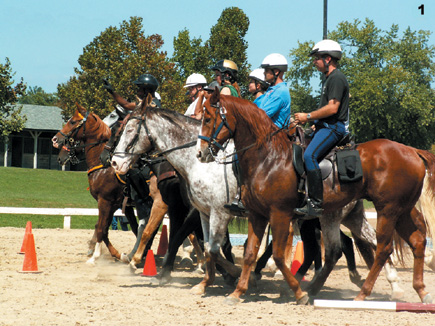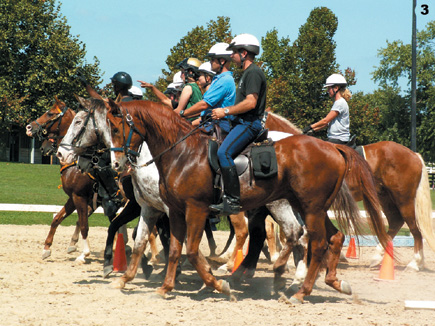Konica Minolta DiMAGE Z3; First Z-Series Digicam With IS Plus New High Tech Features Page 2
Konica Minolta's proprietary CxProcess II technology allows for very fast image processing. Using a high-speed SanDisk ULTRA card, I was able to shoot six full resolution JPEGs in 2.5 seconds before a pause to allow the buffer (temporary storage bank) to clear. The advanced, high-sensitivity 4-megapixel CCD combines with the processor to produce clean colors, pleasing skin tones, and a wide dynamic range that holds detail in both highlight and shadow areas.
Performance Evaluation
In terms of responsiveness and overall speed, the DiMAGE Z3 is no slouch. Powering
up takes only 3 seconds, quite fast for a camera with such a wide range zoom
lens. Touch the shutter release button and focus is confirmed almost instantly
in outdoor photography. There's virtually no shutter lag, making the Z3
great for capturing a fleeting moment without the frustration produced by slower
cameras. Indoors, focus acquisition was not as quick, taking up to one second,
depending on the lighting conditions. A focus-assist beam feature would accelerate
low-light autofocus performance, but this camera with a powerful zoom lens was
primarily intended for outdoor photography.
Although the DiMAGE Z3 includes a wide range of user selectable features, I
was happy with the results produced by Auto White Balance and the default levels
for sharpness, contrast and color saturation. My images exhibit pleasing color
tone, gentle contrast, natural-looking sharpness and moderately vivid colors.
All of these factors can be easily tweaked in camera or using image-editing
software. The post-processing approach is preferable, because the software allows
for greater control and provides a preview of the exact effect that any adjustment
will produce.
The test sample tended to overexpose mid-tone scenes slightly, especially in
bright light. A --0.3 compensation setting solved that problem while a
+0.3 setting was often adequate for lighter-toned subjects such as ball players
in white uniforms. Flash exposure compensation is available too, for varying
flash intensity; I generally set this control to -0.3 as well, or to -0.7 outdoors
for a more subtle effect.
 |
|
 |
|
 |
|
|
Final Assessment
Resolution is about average for a 4-megapixel camera, with high definition of
intricate detail at ISO 50 and 100, moderately high at ISO 200 and acceptable
at ISO 400. JPEG compression is a bit aggressive even in the Large/Fine capture
mode. Consequently, some artifacts (such as jagged edges) are noticeable at
100 percent magnification on a monitor. Still, my best images made for very
good to excellent 8.5x11" ink jet photos at 240dpi after increasing image
file size from 11MB to 15MB in Photoshop.
Digital noise is well controlled at low ISO, but by ISO 400, the colored specks
obliterate some fine detail. This is also typical with many cameras. Fortunately,
I rarely needed to shoot at high ISO with the DiMAGE Z3 because its Anti-Shake
system produced sharp images at surprisingly long shutter speeds. An automatic
noise reduction system kicks in during 1/30 sec and longer exposures, so the
colored specks are less visible in images made at night.
 |
|
|
|
 |
|
|
|
 |
|
|
|
 |
|
|
|
|
At a street price of $499, the Konica Minolta DiMAGE Z3 offers exceptional value, considering its powerful high-grade lens, Anti-Shake function, superb autofocus system, advanced image processor and great versatility. The combination will especially appeal to those who want to shoot sports, wildlife, and stage performances without using a tripod. If you fall into that category, and if you cannot justify the higher price of a digital SLR plus a long zoom lens with image stabilizer, this DiMAGE camera may be a suitable alternative.
PROS
· Highly effective Anti-Shake system compensates for camera shake.
· Superb and powerful lens; Through The Lens viewing and data readouts
with EVF.
· Great versatility with numerous easy to use features; accepts accessory
HS(D) and (D) series flash units but not filters.
· High-speed autofocus, framing and image processing.
· Excellent results in default settings for white balance, color saturation,
contrast, and sharpness; high resolution and minimal noise at ISO 50 and 100.
CONS
· Focus acquisition remains reliable in low light, but is not as quick.
· Overexposes mid-tone subjects slightly in bright light.
· Some JPEG artifacts visible at 100 percent magnification; obvious digital
noise at ISO 400; purple fringing (chromatic aberration) around high contrast
edges.
Contact
Ulead Systems
(310) 896-6388
www.ulead.com
- Log in or register to post comments

































